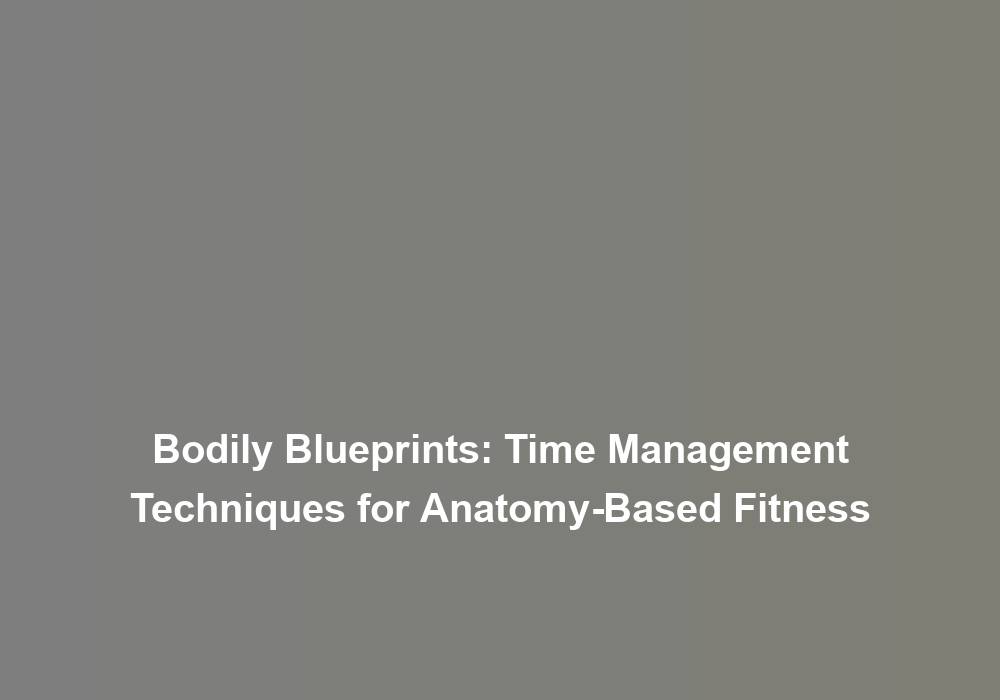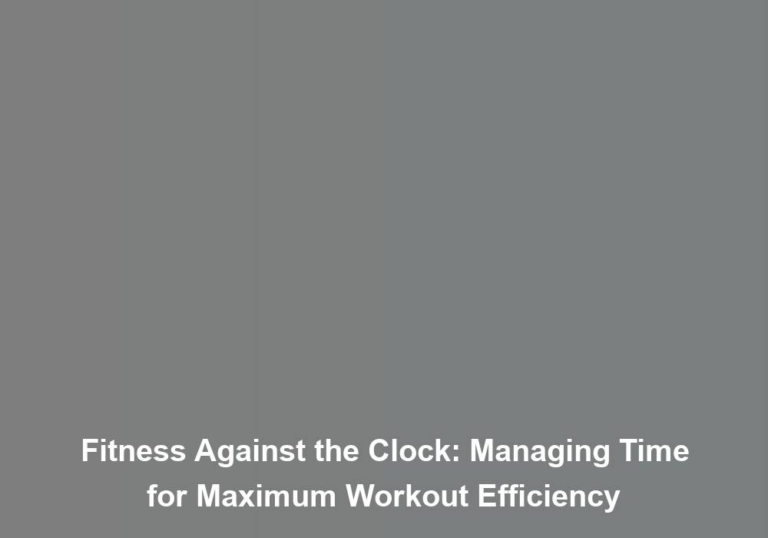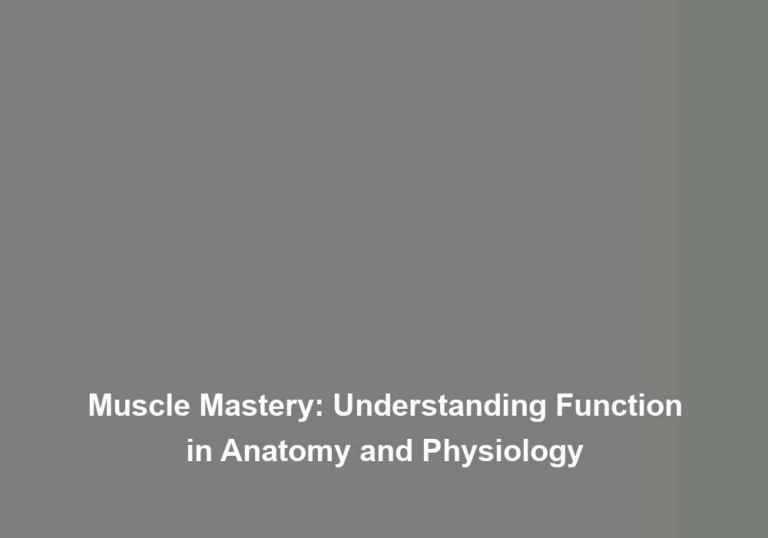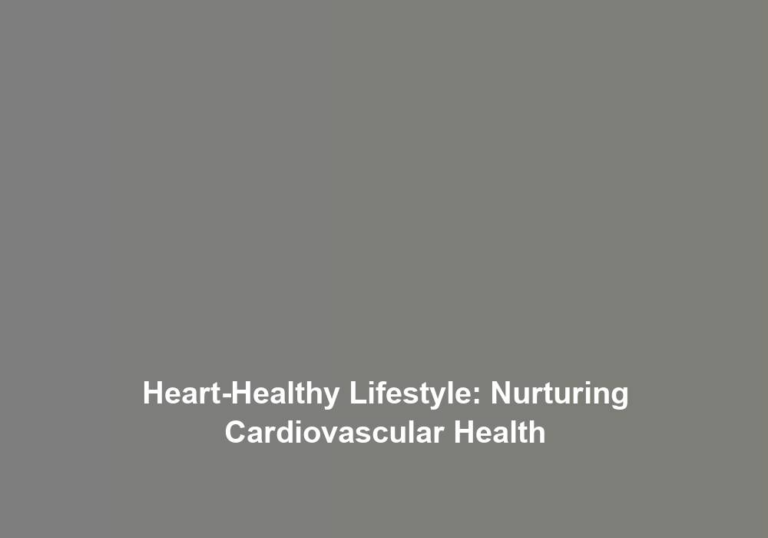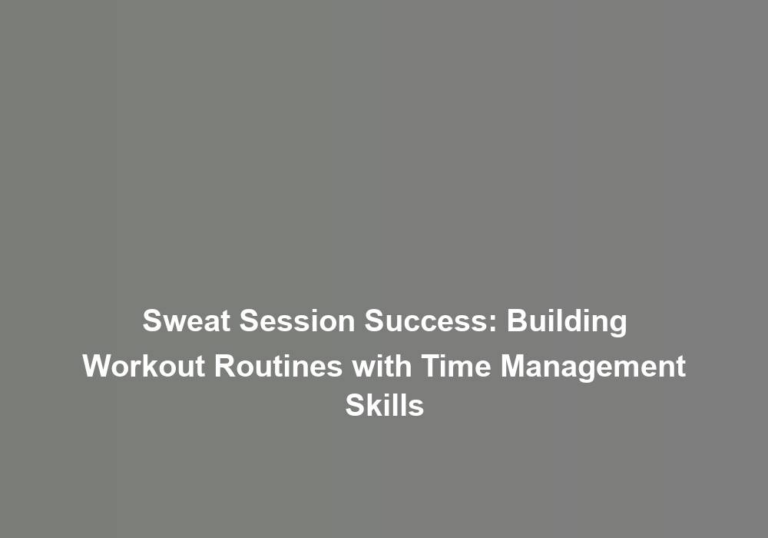Bodily Blueprints: Time Management Techniques for Anatomy-Based Fitness
Are you tired of struggling to find time for your workouts? What if you could align your fitness routine with the natural design of your body, maximizing efficiency and results? Understanding how to manage your time effectively while tailoring exercises to your anatomy can revolutionize your approach to fitness. By incorporating anatomy-based techniques into your workout regimen, you can achieve your fitness goals in a way that complements your bodyG??s unique blueprint. YouG??ll discover how to make the most out of every workout, and ultimately, transform your fitness journey.
Understanding Your BodyG??s Natural Rhythms
Understanding your bodyG??s natural rhythms is essential for effective time management in anatomy-based fitness. Your body clock, also known as your circadian rhythms, plays a crucial role in regulating various physiological processes. These rhythms are approximately 24-hour cycles that influence your sleep-wake patterns, hormone release, body temperature, and metabolism. By understanding and aligning your fitness routine with these natural rhythms, you can optimize your workouts and enhance your overall well-being.
Your body clock impacts your energy levels throughout the day. For most people, energy peaks in the late morning and early evening, while it dips in the afternoon and late at night. Knowing this can help you schedule your workouts for times when your energy levels are naturally higher, leading to more productive and efficient training sessions. Additionally, being aware of your body clock can help you plan your meals around times when your metabolism is most active, supporting better digestion and nutrient absorption.
Furthermore, understanding your circadian rhythms can also help you prioritize recovery and rest. Your bodyG??s natural dip in energy levels at night indicates the importance of quality sleep for overall health and fitness. By structuring your day to align with your body clock, you can ensure that you get adequate rest, allowing your body to recover and repair from your workouts effectively.
Incorporating this knowledge into your fitness routine can lead to better performance, improved recovery, and enhanced overall results, making it an essential aspect of time management in anatomy-based fitness.
Tailoring Workouts to Anatomy
To tailor your workouts to your anatomy effectively, consider your bodyG??s unique structure and capabilities when designing your fitness routines. A customized approach to exercise takes into account your bodyG??s specific needs and limitations, allowing for a more effective and safe workout experience. Developing body awareness is key to understanding how to tailor workouts to your anatomy. By paying attention to how your body moves and feels during exercise, you can make informed decisions about which exercises are most beneficial for you.
| Body Part | Customized Exercise |
|---|---|
| Lower Back | Pilates, yoga, and core exercises |
| Knees | Cycling, swimming, and leg presses |
| Shoulders | Resistance band exercises and shoulder stretches |
| Ankles | Balance exercises and ankle mobility drills |
The table above provides examples of how you can tailor workouts to specific body parts. By customizing exercises to target these areas, you can address any weaknesses or imbalances, ultimately leading to a more well-rounded fitness routine. ItG??s important to remember that everyoneG??s anatomy is different, so what works for one person may not work for another. A tailored approach takes into consideration your unique body structure, promoting a sense of belonging and inclusivity within the fitness community. By embracing a customized approach and developing body awareness, you can optimize your workouts to better suit your individual needs.
Maximizing Exercise Effectiveness
When tailoring your workouts to your anatomy, itG??s essential to focus on maximizing the effectiveness of your exercises to achieve optimal results. To ensure that you are getting the most out of your workouts, consider the following:
-
Effective Scheduling: Incorporating a personalized approach to your exercise routine involves effective scheduling. This means identifying the times of day when you have the most energy and scheduling your workouts during those peak periods. Additionally, consider scheduling high-intensity workouts on days when you feel most capable and reserving lighter exercises for days when your energy levels may be lower.
-
Personalized Approach: Every body is different, and what works for one person may not work for another. Personalizing your approach to exercise involves understanding your bodyG??s unique needs and limitations. This may include modifying exercises to accommodate any existing injuries or physical limitations, as well as choosing exercises that align with your bodyG??s natural strengths.
-
Progressive Overload: Maximizing exercise effectiveness also involves implementing a progressive overload approach. Gradually increasing the intensity, duration, or frequency of your workouts can help ensure that you continue to challenge your body and make progress over time.
Incorporating Anatomy-Based Techniques
Now that youG??ve covered maximizing exercise effectiveness, itG??s time to explore incorporating anatomy-based techniques into your fitness routine. By targeting specific muscle groups and using efficient movement patterns, you can maximize the effectiveness of your workouts. With precision in exercise selection, you can ensure that each movement is tailored to engage the muscles you want to focus on.
Targeted Muscle Engagement
Enhance your workout routine by incorporating targeted muscle engagement techniques rooted in anatomy-based fitness principles, maximizing the effectiveness of your exercises. When focusing on targeted muscle engagement, consider the following:
- Muscle Isolation: Concentrate on specific muscles during each exercise, ensuring effective engagement and optimal results.
- Anatomy Awareness: Understand the anatomy of the muscles you are targeting, allowing for targeted activation and better control over your movements.
- Mind-Muscle Connection: Develop a strong mind-muscle connection to enhance the engagement of the targeted muscles, leading to improved muscle growth and strength.
Efficient Movement Patterns
To optimize your workout efficiency and incorporate anatomy-based techniques, focus on refining your movement patterns for targeted muscle engagement. Movement efficiency is crucial for maximizing the benefits of your workout. By understanding body mechanics and muscular coordination, you can ensure that each movement is purposeful and effective. Functional anatomy plays a key role in designing efficient movement patterns that target specific muscle groups. HereG??s a practical example of how to incorporate anatomy-based efficient movement patterns into your fitness routine:
| Exercise | Movement Pattern |
|---|---|
| Squats | Engage glutes and quadriceps by |
| maintaining proper hip and knee | |
| alignment throughout the movement. |
Precision in Exercise Selection
Incorporate anatomy-based techniques into your exercise selection to ensure precision and effectiveness in targeting specific muscle groups. Form and function go hand in hand in achieving optimal results from your workouts. When it comes to exercise precision, consider the following:
- Anatomy-based exercises: Choose exercises that align with the natural movement and function of specific muscle groups to maximize their engagement and development.
- Mind-muscle connection: Focus on establishing a strong connection between your mind and the specific muscle you are targeting to ensure proper activation and engagement during exercise.
- Range of motion: Pay attention to the full range of motion in each exercise to optimize muscle activation and development while reducing the risk of injury.
Efficient Time Management Strategies
Maximizing productivity in your anatomy-based fitness routine requires implementing effective time management strategies that align with your goals and priorities. Time blocking is a powerful technique that involves setting aside specific blocks of time for different aspects of your fitness routine. Prioritizing tasks within these blocks ensures that you allocate your energy to the most important exercises or activities. By doing so, you can focus on key muscle groups or movements that are crucial to achieving your fitness goals.
Energy management is another vital aspect of efficient time management. ItG??s essential to recognize when your energy levels are highest and plan your most demanding workouts during these peak times. This approach can help you avoid burnout and ensure that you perform at your best during each session. Additionally, incorporating short breaks between exercises or tasks can help replenish your energy and maintain your overall stamina throughout your workout.
When implementing time management strategies, itG??s important to consider factors such as your personal schedule, lifestyle, and individual energy patterns. By effectively managing your time and energy, you can optimize your anatomy-based fitness routine, enhance your overall performance, and prevent exhaustion. Remember that finding the right balance between time management and energy allocation is key to achieving sustainable progress and long-term success in your fitness journey.
Achieving Fitness Goals With Anatomy-Based Fitness
Ready to achieve your fitness goals with anatomy-based fitness? Muscle-targeted workouts and body-specific training plans are key to effectively working towards your desired results. By understanding the anatomy of your body and tailoring your fitness routine to target specific muscles, you can maximize your efforts and see noticeable progress.
Muscle-Targeted Workouts
To effectively target specific muscles and achieve your fitness goals with anatomy-based fitness, itG??s important to tailor your workouts to focus on specific muscle groups. Muscle activation is key to ensure that you are effectively engaging the targeted muscles. Incorporating strength training techniques such as compound movements, isolation exercises, and progressive overload can help you achieve muscle-targeted workouts.
- Compound movements: Engage multiple muscle groups simultaneously, maximizing efficiency.
- Isolation exercises: Target specific muscles to strengthen and tone them individually.
- Progressive overload: Gradually increase the weight, reps, or sets to continuously challenge your muscles for growth and development.
Body-Specific Training Plans
When creating body-specific training plans for anatomy-based fitness, itG??s essential to tailor your workouts to target specific muscle groups effectively. An individualized approach is key to achieving your fitness goals. By identifying your bodyG??s unique strengths and weaknesses, you can develop a training plan that maximizes your efforts. Body-specific exercises, such as lunges for the glutes and squats for the quadriceps, allow you to focus on areas that require attention. For example, if you aim to enhance your core strength, exercises like planks and Russian twists can be incorporated into your routine. Understanding your bodyG??s anatomy enables you to create a targeted plan that addresses your specific needs. By incorporating body-specific exercises into your training regimen, you can optimize your workouts and progress towards your fitness aspirations.
Conclusion
Now that you have learned how to tailor your workouts to your bodyG??s natural rhythms and maximize exercise effectiveness, you can incorporate anatomy-based techniques into your fitness routine. By applying efficient time management strategies, you can achieve your fitness goals more effectively. Understanding your bodyG??s unique needs and working with its natural blueprint will help you make the most of your workouts and see better results in less time. Keep listening to your body and watch your fitness journey unfold.

